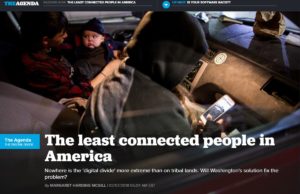POLITICO
By MARGARET HARDING MCGILL 02/07/2018 05:04 AM EST
Photo by M. Scott Mahaskey/POLITICO
OROFINO, Idaho — Alexis Coomer’s house isn’t located in a remote area, at least not compared with many of her fellow Nez Perce tribe members on this reservation in north-central Idaho. She lives in the 3,000-person town of Orofino, the go-to place on the reservation where people load up on groceries and other supplies.
But when she needs to type an email, or help her daughter with homework, she drives 6 miles down the road, along the Clearwater River, and pulls into the Teweepuu Community Center, where she works as an administrative and events aide. There, she sits down in front of the computer she uses for work, which has the broadband hookup she lacks at home.
“It’s not that far, but I just hate having to leave my house,” Coomer said. “I’d rather just stay home.”
As broadband internet becomes more and more important in the U.S. — the way Americans do everything from apply for jobs to chatting with their relatives to watching TV — one gap has become more glaring: the difference between those who have broadband and those who don’t. An estimated 24 million people, about 8 percent of Americans, still have no home access to high-speed internet service, defined by the Federal Communications Commission as a download speed of 25 megabits per second. (That’s what the FCC says allows telecommuting or streaming high-definition video.) The overwhelming majority of those people live in rural areas, like farms or in big, poorly served areas like this one.
You can do something tangible about the Digital Divide
[maxbutton id=”5″ ] [maxbutton id=”1″ ]

